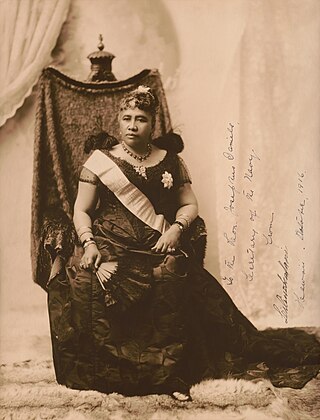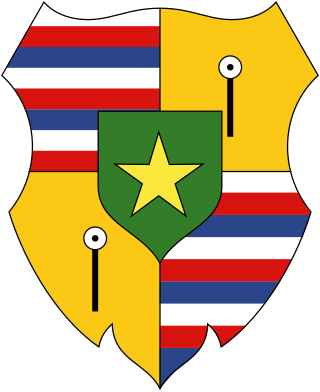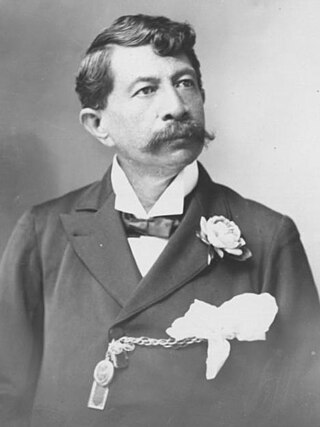
Liliʻuokalani was the only queen regnant and the last sovereign monarch of the Hawaiian Kingdom, ruling from January 29, 1891, until the overthrow of the Hawaiian Kingdom on January 17, 1893. The composer of "Aloha ʻOe" and numerous other works, she wrote her autobiography Hawaiʻi's Story by Hawaiʻi's Queen during her imprisonment following the overthrow.
The history of Hawaii describes the era of human settlements in the Hawaiian Islands. The islands were first settled by Polynesians sometime between 124 and 1120 AD forming the modern population of Native Hawaiians. Hawaiian civilization was isolated from the rest of the world for at least 500 years.

Kalākaua, sometimes called The Merrie Monarch, was the last king and penultimate monarch of the Kingdom of Hawaiʻi, reigning from February 12, 1874, until his death in 1891. Succeeding Lunalilo, he was elected to the vacant throne of Hawaiʻi against Queen Emma. Kalākaua had a convivial personality and enjoyed entertaining guests with his singing and ukulele playing. At his coronation and his birthday jubilee, the hula, which had hitherto been banned in public in the kingdom, became a celebration of Hawaiian culture.

Lunalilo was the sixth monarch of the Kingdom of Hawaii from his election on January 8, 1873, until his death a year later.

Kamehameha III was the third king of the Kingdom of Hawaii from 1825 to 1854. His full Hawaiian name is Keaweaweʻula Kīwalaʻō Kauikeaouli Kaleiopapa and then lengthened to Keaweaweʻula Kīwalaʻō Kauikeaouli Kaleiopapa Kalani Waiakua Kalanikau Iokikilo Kīwalaʻō i ke kapu Kamehameha when he ascended the throne.

Kamehameha V, reigned as the fifth monarch of the Kingdom of Hawaiʻi from 1863 to 1872. His motto was "Onipaʻa": immovable, firm, steadfast or determined; he worked diligently for his people and kingdom and was described as the last great traditional chief.

William Pitt Leleiohoku II, born Kalahoʻolewa, was a prince of the Hawaiian Kingdom and member of the reigning House of Kalākaua.

The House of Kalākaua, or Kalākaua Dynasty, also known as the Keawe-a-Heulu line, was the reigning family of the Kingdom of Hawaiʻi between the assumption of King David Kalākaua to the throne in 1874 and the overthrow of Queen Liliʻuokalani in 1893. Liliʻuokalani died in 1917, leaving only cousins as heirs. The House of Kalākaua was descended from chiefs on the islands of Hawaiʻi and Kauaʻi, and ascended to the royal throne by election when the males of the House of Kamehameha died out. The torch that burns at midday symbolizes the dynasty, based on the sacred kapu Kalākaua's ancestor High Chief Iwikauikaua.
The 1840 Constitution of the Hawaiian Kingdom titled Ke Kumukānāwai a me nā Kānāwai o ko Hawaiʻi Pae ʻĀina, 1840 was the first fully written constitution for the Hawaiian Kingdom. The need for a constitution was originally intended as a manner of laws set forth to control the Native Hawaiian population with a Western style and legal framework, giving less severe punishments, such as being exiled, than was the traditional custom until the 1840s. Christianity had failed to change many behaviors of the Hawaiian population, even with the support of the aliʻi families. Adultery and many other sexual relations became forbidden. Hawaiians were arrested and sentenced to severe punishments that were not well organised. The exiled had little food and could easily swim away from the islands and the prison at Honolulu Fort. The issue became worse as fewer pardons from the aliʻi were available, and the overall sentencing then became much more severe for the native population.

The 1852 Constitution of the Hawaiian Kingdom, written in both English and Hawaiian, was constructed by King Kamehameha III. The purpose of its construction was to not only revise, but add to the 1840 Constitution in great length. The new constitution created a more democratic government much like those of the United States and Europe.

The proposed 1893 Constitution of the Hawaiian Kingdom would have been a replacement of the Constitution of 1887, primarily based on the Constitution of 1864 put forth by Queen Lili'uokalani. While it never became anything more than a draft, the constitution had a profound impact on Hawaiʻi's history: it set off a chain of events that eventually resulted in the overthrow of the Hawaiian Kingdom.

The 1887 Constitution of the Hawaiian Kingdom was a legal document prepared by anti-monarchists to strip the absolute Hawaiian monarchy of much of its authority, initiating a transfer of power to a coalition of American, European and native Hawaiian people. It became known as the Bayonet Constitution for the rising by the armed militia which forced King Kalākaua to sign it or be deposed.

Kuhina Nui was a powerful office in the Kingdom of Hawaiʻi from 1819 to 1864. It was usually held by a relative of the king and was the rough equivalent of the 19th-century European office of Prime Minister or sometimes Regent.
The Great Māhele or just the Māhele was the Hawaiian land redistribution proposed by King Kamehameha III. The Māhele was one of the most important episodes of Hawaiian history, second only to the overthrow of the Hawaiian Kingdom. While intended to provide secure title to indigenous Hawaiians, it separated many of them from their land.

The overthrow of the Hawaiian Kingdom was a coup d'état against Queen Liliʻuokalani, which took place on January 17, 1893, on the island of Oahu and led by the Committee of Safety, composed of seven foreign residents and six Hawaiian Kingdom subjects of American descent in Honolulu. The Committee prevailed upon American minister John L. Stevens to call in the U.S. Marines to protect the national interest of the United States of America. The insurgents established the Republic of Hawaii, but their ultimate goal was the annexation of the islands to the United States, which occurred in 1898.

The Legislature of the Hawaiian Kingdom was the bicameral legislature of the Hawaiian Kingdom. A royal legislature was first provided by the 1840 Constitution and the 1852 Constitution was the first to use the term Legislature of the Hawaiian Islands, and the first to subject the monarch to certain democratic principles. Prior to this the monarchs ruled under a Council of Chiefs.

The Hawaiian Kingdom, or Kingdom of Hawaiʻi, was a sovereign state located in the Hawaiian Islands. The country was formed in 1795, when the warrior chief Kamehameha the Great, of the independent island of Hawaiʻi, conquered the independent islands of Oʻahu, Maui, Molokai and Lānaʻi and unified them under one government. In 1810, the whole Hawaiian archipelago became unified when Kauaʻi and Niʻihau joined the Hawaiian Kingdom voluntarily. Two major dynastic families ruled the kingdom: the House of Kamehameha and the House of Kalākaua.
The Privy Council of the Hawaiian Kingdom, also known as the King's Privy Council of State or Queen's Privy Council of State, was a constitutionally-created body of advisers to the sovereign of the Hawaiian Kingdom from 1845 to 1893. Its members were known as privy councillors and often involved in the other branches of the government.
The Cabinet of the Hawaiian Kingdom was a body of the top executive officials appointed to advise the sovereign of the Hawaiian Kingdom from 1845 to 1893. The subsequent regimes of the Provisional Government and the Republic of Hawaii retained the structure of the cabinet and minister positions under the presidency of Sanford B. Dole from 1893 until 1898.

Edward Kamakau Lilikalani was a political protégé of King Kalākaua of Hawaiʻi. He served more than a decade in the lower house of the Legislature of the Hawaiian Kingdom, and after nearly two decades out of office, was elected to the same legislative body under the Territory of Hawaii. Lilikalani was a member of both Kalākaua's Privy Council of State and Liliʻuokalani's Privy Council of State. Kalākaua decorated him with the Royal Order of Oceania, Order of Oceania, Order of Kalakaua, and Order of Kapiolani.














